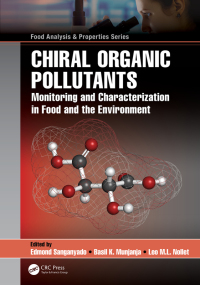Buy Chiral Organic Pollutants: Monitoring and Characterization in Food and the Environment 1st Edition PDF ebook by author Edmond Sanganyado; Basil K. Munjanja; Leo M.L. Nollet – published by CRC Press in 2021 and save up to 80% compared to the print version of this textbook. With PDF version of this textbook, not only save you money, you can also highlight, add text, underline add post-it notes, bookmarks to pages, instantly search for the major terms or chapter titles, etc.
You can search our site for other versions of the Chiral Organic Pollutants: Monitoring and Characterization in Food and the Environment 1st Edition PDF ebook. You can also search for others PDF ebooks from publisher CRC Press, as well as from your favorite authors. We have thousands of online textbooks and course materials (mostly in PDF) that you can download immediately after purchase.
Note: e-textBooks do not come with access codes, CDs/DVDs, workbooks, and other supplemental items.
eBook Details:
Full title: Chiral Organic Pollutants: Monitoring and Characterization in Food and the Environment 1st Edition
Edition: 1st
Copyright year: 2021
Publisher: CRC Press
Author: Edmond Sanganyado; Basil K. Munjanja; Leo M.L. Nollet
ISBN: 9781003000167, 9780429531873
Format: PDF
Description of Chiral Organic Pollutants: Monitoring and Characterization in Food and the Environment 1st Edition:
This timely and unique publication is designed for graduate students and researchers in inorganic and materials chemistry and covers bonding models and applications of symmetry concepts to chemical systems. The book discusses the quantum mechanical basis for molecular orbital concepts, the connections between molecular orbitals and localized views of bonding, group theory, bonding models for a variety of compounds, and the extension of these ideas to solid state materials in band theory. Unlike other books, the concepts are made tangible to the readers by guiding them through their implementation in MATLAB functions. No background in MATLAB or computer programming is needed; the book will provide the necessary skills. Key Features Visualization of the Postulates of Quantum Mechanics to build conceptual understanding MATLAB functions for rendering molecular geometries and orbitals Do-it-yourself approach to building a molecular orbital and band theory program Introduction to Group Theory harnessing the 3D graphing capabilities of MATLAB Online access to a growing collection of applications of the core material and other appendices Bonding through Code?is ideal for first-year graduate students and advanced undergraduates in chemistry, materials science, and physics. Researchers wishing to gain new tools for theoretical analysis or deepen their understanding of bonding phenomena can also benefit from this text.? About the Author Daniel Fredrickson is a Professor in the Department of Chemistry at the University of Wisconsin-Madison, where his research group focuses on understanding and harnessing the structural chemistry of intermetallic phases using a combination of theory and experiment. His interests in crystals, structure, and bonding can be traced to his undergraduate research at the University of Washington (B.S. in Biochemistry, 2000) with Prof. Bart Kahr, his Ph.D. studies at Cornell University (2000-2005) with Profs. Stephen Lee and Roald Hoffmann, and his post-doctoral work with Prof. Sven Lidin at Stockholm University (2005-2008). As part of his teaching at UW-Madison since 2009, he has worked to enhance his department’s graduate course, Physical Inorganic Chemistry I: Symmetry and Bonding, through the incorporation of new material and the development of computer-based exercises.





